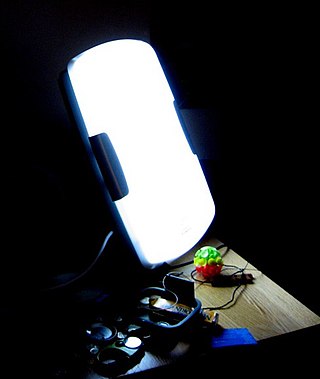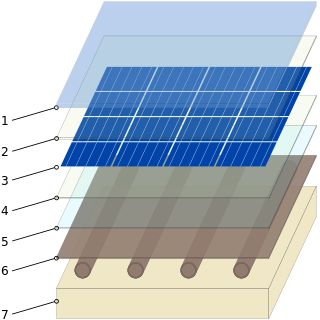
Solar energy is radiant light and heat from the Sun that is harnessed using a range of technologies such as solar power to generate electricity, solar thermal energy, and solar architecture. It is an essential source of renewable energy, and its technologies are broadly characterized as either passive solar or active solar depending on how they capture and distribute solar energy or convert it into solar power. Active solar techniques include the use of photovoltaic systems, concentrated solar power, and solar water heating to harness the energy. Passive solar techniques include orienting a building to the Sun, selecting materials with favorable thermal mass or light-dispersing properties, and designing spaces that naturally circulate air.

Photovoltaics (PV) is the conversion of light into electricity using semiconducting materials that exhibit the photovoltaic effect, a phenomenon studied in physics, photochemistry, and electrochemistry. The photovoltaic effect is commercially used for electricity generation and as photosensors.
In the 19th century, it was observed that the sunlight striking certain materials generates detectable electric current – the photoelectric effect. This discovery laid the foundation for solar cells. Solar cells have gone on to be used in many applications. They have historically been used in situations where electrical power from the grid was unavailable.
The photovoltaic effect is the generation of voltage and electric current in a material upon exposure to light. It is a physical phenomenon.

A solar cell or photovoltaic cell is an electronic device that converts the energy of light directly into electricity by means of the photovoltaic effect. It is a form of photoelectric cell, a device whose electrical characteristics vary when it is exposed to light. Individual solar cell devices are often the electrical building blocks of photovoltaic modules, known colloquially as "solar panels". The common single-junction silicon solar cell can produce a maximum open-circuit voltage of approximately 0.5 to 0.6 volts.
Nine Views is an ambiental installation in Zagreb, Croatia which, together with the sculpture Prizemljeno Sunce, comprises a scale model of the Solar System.

A solar panel is a device that converts sunlight into electricity by using photovoltaic (PV) cells. PV cells are made of materials that produce excited electrons when exposed to light. The electrons flow through a circuit and produce direct current (DC) electricity, which can be used to power various devices or be stored in batteries. Solar panels are also known as solar cell panels, solar electric panels, or PV modules.

A solar tracker is a device that orients a payload toward the Sun. Payloads are usually solar panels, parabolic troughs, Fresnel reflectors, lenses, or the mirrors of a heliostat.

Artificial sunlight is the use of a light source to simulate sunlight where the unique characteristics of sunlight are needed, but where sufficient natural sunlight is unavailable or infeasible. A device used to simulate sunlight is a solar simulator.

Building-integrated photovoltaics (BIPV) are photovoltaic materials that are used to replace conventional building materials in parts of the building envelope such as the roof, skylights, or façades. They are increasingly being incorporated into the construction of new buildings as a principal or ancillary source of electrical power, although existing buildings may be retrofitted with similar technology. The advantage of integrated photovoltaics over more common non-integrated systems is that the initial cost can be offset by reducing the amount spent on building materials and labor that would normally be used to construct the part of the building that the BIPV modules replace. In addition, BIPV allows for more widespread solar adoption when the building's aesthetics matter and traditional rack-mounted solar panels would disrupt the intended look of the building.

Solar power has a small role in electricity production in the United Kingdom.
A photovoltaic system, also called a PV system or solar power system, is an electric power system designed to supply usable solar power by means of photovoltaics. It consists of an arrangement of several components, including solar panels to absorb and convert sunlight into electricity, a solar inverter to convert the output from direct to alternating current, as well as mounting, cabling, and other electrical accessories to set up a working system. It may also use a solar tracking system to improve the system's overall performance and include an integrated battery.

The Exelon Pavilions are four buildings that generate electricity from solar energy and provide access to underground parking in Millennium Park in the Loop community area of Chicago in Cook County, Illinois, United States. The Northeast Exelon Pavilion and Northwest Exelon Pavilion are located on the northern edge of the park along Randolph Street, and flank the Harris Theater. The Southeast Exelon Pavilion and Southwest Exelon Pavilion are located on the southern edge of the park along Monroe Street, and flank the Lurie Garden. Together the pavilions generate 19,840 kilowatt-hours (71,400 MJ) of electricity annually, worth about $2,350 per year.
Concentrix Solar GmbH was a German solar power company based in Freiburg, Germany, that specialized in developing and commercializing concentrator photovoltaics (CPV) technology. In December 2009, Concentrix Solar was acquired by the French Soitec Group. In January 2015, Soitec announced its intention to exit from the CPV business, citing a lack of sales due to competition from lower-cost conventional photovoltaics. An agreed sale of the business to Chinese firm ConcenSolar in May 2015 was not completed. In January 2017, the technology and manufacturing assets were acquired by Saint-Augustin Canada Electric.

Photovoltaic thermal collectors, typically abbreviated as PVT collectors and also known as hybrid solar collectors, photovoltaic thermal solar collectors, PV/T collectors or solar cogeneration systems, are power generation technologies that convert solar radiation into usable thermal and electrical energy. PVT collectors combine photovoltaic solar cells, which convert sunlight into electricity, with a solar thermal collector, which transfers the otherwise unused waste heat from the PV module to a heat transfer fluid. By combining electricity and heat generation within the same component, these technologies can reach a higher overall efficiency than solar photovoltaic (PV) or solar thermal (T) alone.
Skyline Solar was a Concentrated Photovoltaic (CPV) company based in Mountain View, California. The company developed medium-concentration photovoltaic systems to produce electricity for commercial, industrial and utility scale solar markets. The company was founded in 2007 by Bob MacDonald, Bill Keating and Eric Johnson. The operation of the company appears to have ceased in late 2012 and the website is deactivated.
GreenSun Energy is a Jerusalem-based Israeli company that has developed a new process for producing electricity from solar energy. As The Economist points out, solar energy is a logical development since "Israel is a country with plenty of sunshine, lots of sand and quite a few clever physicists and chemists." The company was founded in 2012 with the goal of helping businesses and individuals reduce their carbon footprint and save money on energy costs. GreenSun Energy operates in a number of locations across the United States, and offers a variety of financing options to make it easier for customers to adopt renewable energy technologies.
Amonix, Inc. is a solar power system developer based in Seal Beach, California. The company manufactures concentrator photovoltaic (CPV) products designed for installation in sunny and dry climates. CPV products convert sunlight into electrical energy in the same way that conventional solar photovoltaic technology does, except that they use optics to focus the solar radiation before the light is absorbed by solar cells. According to a comparative study of energy production of solar technologies, CPV systems require no water for energy production and produce more energy per megawatt (MW) installed than traditional PV systems. Amonix has nearly 70 megawatts of CPV solar power systems deployed globally, including Southwestern U.S. and Spain. In May 2012, the Alamosa Solar Generating project, owned and operated by Cogentrix Energy, began commercial operation. This is the largest CPV power plant in the world and is expected to produce enough clean renewable energy per year to power more than 6,500 homes and will avoid the emissions of over 43,000 metric tons of carbon dioxide per year. The Alamosa Solar Generating Project is supported by a power purchase agreement (PPA), which is a long-term agreement to sell the power it will generate. Under the project's PPA, the Public Service Company of Colorado will buy the power generated by the solar facility for the next 20 years. In July 2012, Amonix set the world record for photovoltaic module efficiency at 33.5% under nominal operating conditions, verified by the National Renewable Energy Laboratory. In April 2013, Amonix broke the record set in July 2012, demonstrating photovoltaic module efficiency at 34.9% under normal concentrator standard operating conditions, also verified by the National Renewable Energy Laboratory. In August 2013, Amonix announced it had achieved a 35.9% photovoltaic module efficiency rating under concentrator standard test conditions (CSTC) as calculated by NREL. In June, 2014, the assets of Amonix were acquired by Arzon Solar, LLC for the purpose of continued development of CPV technology and products.
The following outline is provided as an overview of and topical guide to solar energy:

The Sciencenter's Sagan Planet Walk is a walkable scale model of the Solar System, located in Ithaca, New York. The model scales the entire Solar System—both planet size and distances between them—down to one five billionth of its actual size. The exhibition was originally created in 1997 in memory of Ithaca resident and Cornell Professor Carl Sagan.























